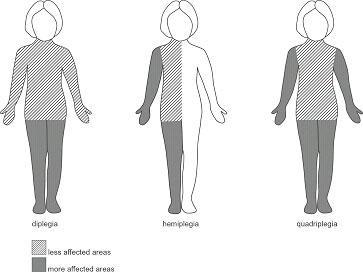What is Cerebral Palsy?
Cerebral Palsy comes from brain damage that happened before the baby was born, at birth or as a baby. Once the brain is damaged, the part(s) of the brain that suffered damage does not recover, nor does it get worse. However, early intervention may impact the child by reprogramming undamaged parts of the brain to take over and do the work of the damaged parts.

Causes of Cerebral Palsy
Before birth – infections including shingles and German measles, differences between the blood of mother and child (Rh), problems with mother such as diabetes and toxemia of pregnancy, inherited (rare), and no cause (about 30% of children).
Around time of birth – lack of oxygen, birth injuries and prematurity.
After birth – very high fever, untreated jaundice, brain infection such as meningitis and encephalitis, head injuries, lack of oxygen, bleeding or blood clots in the brain, and brain tumors.
Some Early Signs of Cerebral Palsy:
- At birth, a baby may be limp or floppy.
- A baby may not breathe immediately after birth and may turn blue.
- A child may seem to be developing more slowly than other children.
- A child may not use one of his hands.
- A child may have problems with sucking, swallowing, chewing and may choke easily.
- A child may stiffen when she is carried, dressed or washed.
- A child may cry a lot and seem irritable or may be very quiet and almost never cry or smile.
- A child may not respond or react like other children do and they may develop speech and language skills later than usual.
- Intelligence may be affected, but do not make this judgment too soon. Sometimes, lack of speech or twisted facial muscles or slowness to respond may cause a child to be labeled mentally retarded when in fact they are not. Hearing and sight may also be impaired.
- Some children may have fits or seizures.
- Some children may have behavioral problems due to the brain damage or they may be frustrated by their limitations.
- Some children may not be able to control their body movements and they may appear awkward. Balance could also be affected.
Medical Treatments for Cerebral Palsy
No medicines will cure cerebral palsy. Medicine can be given to help control fits/seizures (Phenobarbital, Depakene). Medicine to relax muscles and reduce tone (Lioresal-Baclofen) can be given in severe cases.
Surgery: There is no brain surgery that will cure the problems associated with cerebral palsy. There are a few types of surgery which help improve movement and decrease tightness in joints but it is generally only done if there is potential to improve the child’s ability to function (walk, crawl or be positioned in a wheel chair). If follow up is not good, the problem may come back.
Botox: Botox is a non surgical treatment for spasticity. A small amount of poison (botulinum toxin) is injected into a tight muscle. This causes an isolated, temporary paralysis in that muscle. The effects last about 3 months. Because the closest provider of this treatment technique is in Mexico and because follow up is required every three months, this is currently not a viable treatment option for children in Belize.
How to Prevent Cerebral Palsy
- Good nutrition of the mother
- Avoid pregnancy until full grown (16 or 17 years old)
- Avoid unnecessary medicines during pregnancy
- Avoid contact with German measles (Rubella)
- Go for regular health check ups during pregnancy
- Breast feed baby
- Vaccinate the baby